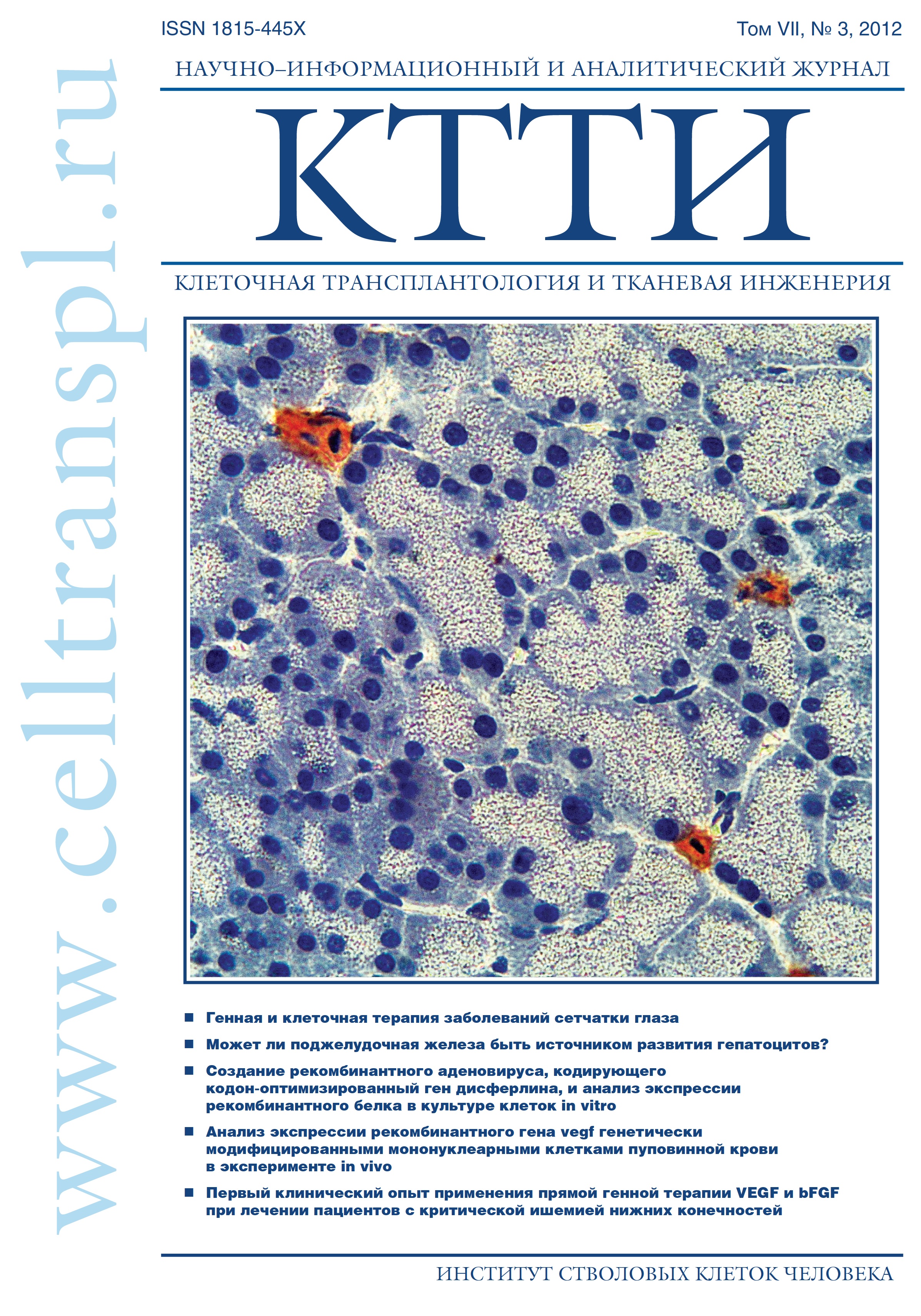Endogenous secretion of vascular endothelial growth factor by multipotent mesenchymal stromal cellsderived from human third molar dental follicles
- Authors: Solovyeva VV1, Blatt NL1, Shafigullina AK2, Rizvanov AA1
-
Affiliations:
- Kazan (Volga Region) Federal University, Kazan
- Kazan State Medical University, Kazan
- Issue: Vol 7, No 3 (2012)
- Pages: 155-158
- Section: Articles
- URL: https://genescells.ru/2313-1829/article/view/121668
- DOI: https://doi.org/10.23868/gc121668
- ID: 121668
Cite item
Abstract
Human stem cells secretome is currently a very hot area
of research. We report that multipotent mesenchymal stromal
cells isolated from human third molar dental follicles (MMSCTMDF),
are able to secrete high levels of vascular endothelial
growth factor (VEGF) when cultured in vitro. Due to the fact
that VEGF is a well known angiogenic and neuroprotective
factor, the use of MMSC-TMDF is promising for the
development of stem cell therapy of various degenerative
human diseases.
of research. We report that multipotent mesenchymal stromal
cells isolated from human third molar dental follicles (MMSCTMDF),
are able to secrete high levels of vascular endothelial
growth factor (VEGF) when cultured in vitro. Due to the fact
that VEGF is a well known angiogenic and neuroprotective
factor, the use of MMSC-TMDF is promising for the
development of stem cell therapy of various degenerative
human diseases.
About the authors
V V Solovyeva
Kazan (Volga Region) Federal University, KazanKazan (Volga Region) Federal University, Kazan
N L Blatt
Kazan (Volga Region) Federal University, KazanKazan (Volga Region) Federal University, Kazan
A K Shafigullina
Kazan State Medical University, KazanKazan State Medical University, Kazan
A A Rizvanov
Kazan (Volga Region) Federal University, KazanKazan (Volga Region) Federal University, Kazan
References
- Hathout Y. Approaches to the study of the cell secretome. Expert. Rev. Proteomics. 2007; 4(2): 239-48.
- Chenau J., Michelland S., Seve M. Secretome: definitions and biomedical interest. Rev. Med. Interne. 2008; 29(7): 606-8.
- Estrada R., Li N., Sarojini H. et al. Secretome from mesenchymal stem cells induces angiogenesis via Cyr61. J. Cell Physiol. 2009; 219(3): 563-71.
- Justewicz D.M., Shokes J.E., Reavis B. et al. Characterization of the human smooth muscle cell secretome for regenerative medicine. Tissue Eng. Part C Methods, 2012.
- Kim J.M., Kim J., Kim Y. et al. Comparative secretome analysis of human bone marrow-derived mesenchymal stem cells during osteogenesis. J. Cell Physiol. 2012. Epub ahead of print.
- Домарацкая Е.И., Стволовые клетки - резиденты кост- ного мозга. Известия Российской академии наук 2011; 3: 261-72.
- Pevsner-Fischer M., Levin S., Zipori D. The origins of mesenchymal stromal cell heterogeneity. Stem Cell Rev. 2011; 7(3): 560-8.
- Tziafas D., Kodonas K. Differentiation potential of dental papilla, dental pulp, and apical papilla progenitor cells. J Endod. 2010; 36(5): 781-9.
- Yalvac M.E., Ramazanoglu M., Rizvanov AA. et al. Isolation and characterization of stem cells derived from human third molar tooth germs of young adults: implications in neo-vascularization, osteo-, adipo- and neurogenesis. Pharmacogenomics 2010; 10(2): 105-13.
- Tarnok A., Ulrich H., Bocsi J. Phenotypes of stem cells from diverse origin. Cytometry 2010; 77(1): 6-10.
- Gronthos S., Mankani M., Brahim J. et al. Postnatal human dental pulp stem cells (DPSCs) in vitro and in vivo. PNAS USA 2000; 97(25): 13625-30.
- Morsczeck C., Götz W., Schierholz J. et al. Isolation of precursor cells (PCs) from human dental follicle of wisdom teeth. Matrix Biol. 2005; 24(2): 155-65.
- Yao S., Pan F., Prpic V. et al. Differentiation of stem cells in the dental follicle. J Dent. Res. 2008; 87(8): 767-71.
- Kerkis I., Ambrosio C.E., Kerkis A. et al. Early transplantation of human immature dental pulp stem cells from baby teeth to golden retriever muscular dystrophy (GRMD) dogs: Local or systemic? J. Transl. Med. 2008; 6: 35.
- Nosrat I.V., Widenfalk J., Olson L. et al. Dental pulp cells produce neurotrophic factors, interact with trigeminal neurons in vitro, and rescue motoneurons after spinal cord injury. Dev. Biol. 2001; 238(1): 120-32.
- Storkebaum E., Lambrechts D., Carmeliet P. VEGF: once regarded as a specific angiogenic factor, now implicated in neuroprotection. Bioessays 2004; 26(9): 943-54.
- Patan S. Vasculogenesis and angiogenesis. Cancer Treat. Res. 2004; 117: 3-32.
- Sun Y., Jin K., Xie L. et al. VEGF-induced neuroprotection, neurogenesis, and angiogenesis after focal cerebral ischemia. J. Clin. Invest. 2003; 111(12): 1843-51.
- Jin K., Zhu Y., Sun Y. et al. Vascular endothelial growth factor (VEGF) stimulates neurogenesis in vitro and in vivo. PNAS USA 2002; 99(18): 11946-50.
- Yalvac M.E., Ramazanoglu M., Gumru O.Z. et al. Comparison and optimisation of transfection of human dental follicle cells, a novel source of stem cells, with different chemical methods and electroporation. Neurochem. Res. 2009; 34(7): 1272-7.
- Harris J.H., Graham J., Rickwood D. Cell Biology Protocols. John Wiley & Sons, Ltd.; 2006.
- Hawley T.S., Hawley R.G., Totowa N.J. Flow Cytometry Protocols 2ed. Methods in Molecular Biology. Humana Press; 2004.
Supplementary files










